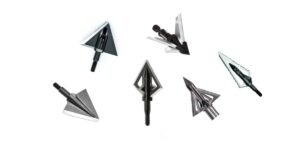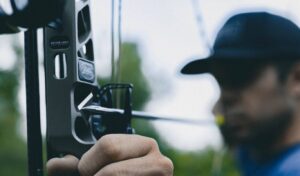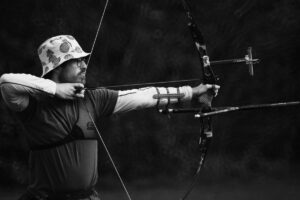When preparing for any bowhunt, a few tasks are as vital as ensuring that all of your gear is adequately prepared and ready for use in the moment of truth.
We, as bowhunters, rely upon our gear to function as intended when needed. It is also our responsibility to the game that we hunt to make sure our archery tackle is capable of executing a clean, ethical kill in every instance.
Of all of our gear, few items are as vital to success as the broadheads at the ends of our arrows. We rely upon these heads to slice through the vitals of our quarry, unabated by any unforeseen obstacles.
While many place ample thought into broadhead selection, few new bowhunters place as much consideration into installing their broadheads until required to do so out of necessity.
Contents (Jump to Topic)
ToggleThe following guide is designed to ease this learning curve by providing every necessary detail required to install your broadheads before use.
Safety First
Before proceeding, we must cover the finer points of broadhead safety. Broadheads are similar in design to razor blades, carrying extremely sharp edges. A broadhead can inflict severe cuts if mishandled, even necessitating medical care. Therefore, caution should be taken when assembling, sharpening, or installing broadheads of any type.
Wear Gloves
It is best to wear gloves when handling broadheads, as this prevents one from injuring themselves if accidental contact is made with one or more blades. Additionally, the use of gloves prevents you from fumbling a broadhead if your hands were to become wet with sweat or slick from the natural oils on your fingertips.
Use a Broadhead Wrench

Universal Archery Broadhead Wrench
Additionally, a specialty wrench, known simply as a broadhead wrench, should be used to tighten a broadhead in place whenever possible. This eliminates any unnecessary hand-to-broadhead contact, thus preventing needless injury. While some broadheads come with wrenches of this type, others do not. Regardless, broadhead wrenches can be purchased from most outdoor retailers or ordered online.
Proper Storage
Loose broadheads that have yet to be installed on an arrow shaft, but have been removed from their original packaging, should be stored inside a closed container of one sort or another. This prevents you, or someone else, from inadvertently becoming injured when reaching for them when stored away.
Installing Broadheads #101
Today, most broadheads are threaded, allowing for securement to a threaded insert placed within the forward end of an arrow. These threads must properly engage those of the insert that the broadhead in question is to be affixed to. However, you must ensure that their broadhead is fully assembled and ready for use before doing so.
Most of today’s broadheads come pre-assembled and ready for installation. However, a limited number of fixed-blade models still require moderate assembly. Typically, doing so involves inserting the broadhead’s blades into their corresponding slots within the head’s ferrule. A tip is then threaded onto the outer edge of the broadhead, securing the blades in place.
Alternatively, some fixed blade broadheads require the placement of a specialty o-ring or retainment collar. These items should be situated and checked for proper fitment before installing the broadhead itself onto any arrow shaft.
In any event, one should carefully follow all manufacturer recommendations regarding broadhead installation. Each broadhead differs slightly in design, and correct assembly can easily serve as the difference between success and a world of regret. If you have any doubts about the assembly of your broadheads, contact the manufacturer directly for additional direction.
Steps To Success
The following steps can be followed to install a broadhead on an arrow shaft. These steps are largely universal, no matter one’s choice in a broadhead.
Step 1: Remove Practice Tip
To begin, remove your arrows’ practice tips by gently threading them in a counterclockwise direction. Place these practice heads in a secure location for future use later.
Step 2: Inspect Insert
Next, carefully inspect your arrow’s insert, checking thoroughly for cracking or damaged threads. Also, check to ensure that the insert is fully seated in the arrow shaft, without wiggle room or free-play. If at all possible, any dirt or debris present within the insert should also be removed before proceeding to step #3.
Step 3: Put On Protective Gloves
You should now put on a pair of protective gloves. Doing so can prevent hand injury if an inadvertent mishap occurs.
Step 4: Thread The Broadhead Into Place
With gloved hands, carefully insert the threaded end of your broadhead into your arrow’s insert. Carefully turn the broadhead clockwise while feeling for the threads to engage. Be careful to avoid cross-threading, as a failure to do so can result in severe insert/broadhead damage. Continue to thread the broadhead in a clockwise direction until the head bottoms out and slight resistance is felt.
Step 5: Tighten As Needed
You will now tighten your broadhead until snug within your arrow’s insert. This should be done with a broadhead wrench to avoid injury if at all possible. If you do not have a broadhead wrench at your disposal, take care to avoid placing your fingertips directly upon the broadhead’s ultra-sharp blades, even with a gloved hand. You will tighten your broadhead until it is moderately snug.
You are then ready to repeat steps #1-#5 with as many broadheads/arrows as desired.
Additional Tip:
Though it might be tempting to tighten your broadheads as tight as possible, doing so can prove detrimental at best. Overtightening of a broadhead can strip the tip’s threaded shank or the threads of your arrow’s insert. This, in turn, can cause a number of significant issues, including a failure of the broadhead/insert to tighten at all. Remember, a broadhead must be snug but should not be cranked down as tight as humanly possible.
Broadhead Installation Made Easy
Though somewhat intimidating at first for many beginning archers, installing broadheads onto your arrow shafts of choice can be completed without much to do.
After gaining a little experience, you can install an entire quiver’s worth of broadheads without missing a beat in a couple of minutes. Above all else, you should take care around broadheads to prevent injury, giving them the ample respect that they most certainly deserve.
What is a broadhead wrench used for?
A broadhead wrench is a tool that is used to tighten or loosen the broadhead arrow on the arrow shaft. This tool is essential for safely and securely attaching the broadhead to the arrow.
Without a proper fitting and secure attachment, the broadhead could cause a dangerous situation. A broadhead wrench is a crucial piece of equipment that ensures the safe installation of broadhead arrows.
Glossary & Overall Information
Arrow tips, also known as arrowheads, are the pointed tips of an arrow that penetrate the target when shot. There are various types of arrowheads available for archers, such as field points, blunt tips, and broadheads.
Broadheads are a popular type of arrowhead that feature large cutting blades that are fixed or expandable. Fixed broadheads are stationary, meaning their blades are permanently attached to the arrow shaft. This type of arrowhead is preferred by many hunters because of its reliability and ability to inflict devastating damage on their targets.
Small game hunting, on the other hand, is usually conducted with blunt or small broadheads that are designed to deliver a less lethal blow. These arrowheads are perfect for taking down small game like rabbits and squirrels without causing their flesh to become too damaged.
When it comes to big game hunting, hunters typically choose to use broadheads with larger cutting surfaces and higher kinetic energy. These broadheads are designed to deliver a powerful, fatal blow to larger animals like deer, elk, and moose.
There are always new archery products being developed, and the same goes for arrow tips and broadheads. Recently, manufacturers have been designing broadheads with more advanced features like better penetration, accuracy, and noise reduction. Some hunters are also experimenting with more unconventional arrowhead designs, such as single-bevel broadheads and hybrid-tipped broadheads.
In order to screw on broadhead arrows, it is important to consider a few factors such as the type of broadhead being used, arrow weight, arrow material, and arrow flight characteristics.
Single bevel broadheads are a popular choice for hunters because they are known for their ability to penetrate deeply and create a large wound channel. They are designed with a sharp angled edge on one side of the blade, which creates a greater cutting surface and enhances their ability to penetrate. When screwing on single bevel broadheads, it is important to make sure that they are screwed on tightly and securely to prevent them from becoming loose during flight.
Arrow weight is another important factor to consider when screwing on broadhead arrows. Generally, heavier arrows tend to be more stable and accurate, especially over long distances. The weight of the arrow should be chosen based on the intended use – whether for target practice or hunting.
Wood arrows are a popular choice for traditional archers because of their natural look and feel. However, they can be more sensitive to changes in temperature and humidity, which can affect their flight characteristics. When using wood arrows, it is important to regularly inspect and maintain them to ensure proper alignment and stability during flight.
Arrow flight refers to the trajectory and accuracy of the arrow when shot from a bow. The arrow’s flight characteristics can be affected by many factors, including arrow weight, arrow length, arrow material, fletching, and broadhead type. When choosing a broadhead to screw onto an arrow, it is important to consider its compatibility with the arrow and its flight performance.
Mechanical broadheads, also known as expandable broadheads, are designed with blades that deploy upon impact to create a larger wound channel and increase their effectiveness. When screwing on mechanical broadheads, it is important to ensure that they are aligned properly with the arrow shaft to prevent any unnecessary drift or wobble during flight.







